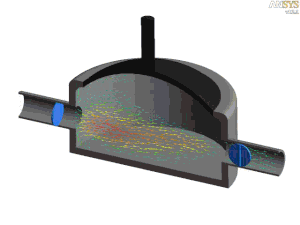Pressure membrane
A pressure membrane (from late Middle High German membrāne " piece of parchment " from Latin membrāna " skin ") is an impermeable, movable component in measurement and conveyor technology .
properties

Pressure membranes are mostly made of plastic, but sometimes also of metal. They have the advantage that they transmit power and seal at the same time .
In addition, the other mechanical components of an installation are located outside of the medium to be measured or conveyed, which means that less dead space is created, contamination is avoided and other materials can be used because there is no interaction with the medium.
Applications
A frequent application is the diaphragm pump for conveying liquids or gases, which is particularly insensitive to continuous stress and contamination in the conveyed material.
The diaphragm valve , which is a way of controlling fluids (gases, steam, liquids), offers comparable advantages . In particular, highly viscous and / or highly adhesive media are thus z. B. distributed or dosed .
Another important area of application is pressure measurement . Here too, the advantage of simultaneous sealing is used. One example is the diaphragm manometer . The gas pressure is measured by bending a thin sheet of metal and thereby turning a pointer.
